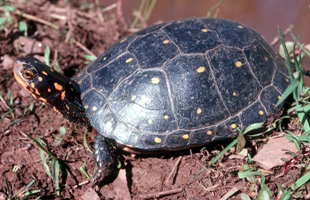As is true of most turtles, the sex of a spotted turtle hatchling depends on the temperature of the egg during incubation. Eggs incubated at warmer temepratures tend to become females, while eggs incubated at cooler temperatures tend to become males.
Photo Credit: Geoffrey A. Hammerson
Clemmys guttata
Common Name: spotted turtle
Animal Guild: Reptile
Class > Order > Family: Reptilia > Testudines > Emydidae
What does the species look like?
Spotted turtles have a hard, somewhat flattened shell. Their upper shell is black and usually has scattered, rounded, yellow spots. They also have yellow or orange spots on their head and neck. Their lower shell is yellow or yellow-orange and has a large, black blotch on each scute (plate or scale). Their upper shell can reach a length of about 5.1 inches (13 cm).
Mature males: The anal opening is located beyond the rear edge of their upper shell when the tail is extended. Their chin is tan or dark, and their lower shell is concave.
Mature females: The anal opening is at or inside the rear edge of their upper shell when the tail is extended. Their chin is yellowish.
Hatchlings: The young usually have one yellow spot on each large scute on their upper shell.
Where is the species found?
States & Provinces
CT, DC, DE, FL, GA, IL, IN, MA, MD, ME, MI, NC, NH, NJ, NY, OH, ON, PA, QC, RI, SC, VA, VT, WV
Distribution
The range extends from southern Maine, southern Quebec, southern Ontario, Michigan (Lower Peninsula), and northeastern Illinois south to central Indiana, central Ohio, and southwestern Pennsylvania, and southward along the U.S. east coast from New England to northern Florida.
They can move among different types of wetlands depending on the season and may spend a lot of time on land during summer. They lay their eggs in well-drained, marshy pastures, in clumps of grass, sedge, or moss, in open areas (e.g., dirt paths or roads) at the edge of thick vegetation, along powerline rights-of-way, on the edges of recent clearcuts, or at similar sites.
General Phenology and Life History
Spotted turtles are most active during daytime in spring and are relatively inactive in summer, fall, and winter, though sometimes they are active in September and October. During summer drought, they may become inactive. At the northern extent of the range in central Ontario, spotted turtles are active from early or mid-April through late October or early November, longer than most southern populations. Females may move several hundred yards or meters from a wetland to nest on dry ground. They mate from March to May. They lay eggs in late May through early July, mostly in June. The eggs incubate for 45 to 83 days, depending on the temperature of the nest. Eggs hatch in late August to September, and hatchlings usually move quickly from the dry areas where they hatch to wetlands. On rare occassions, turtles that hatch late may spend the winter in the nest and emerge the following spring.
Which phenophases should I observe?
Do you see/hear...?
Activity
Individuals on land More...
For abundance, enter the number of individual animals observed in this phenophase.
Individuals in water More...
For abundance, enter the number of individual animals observed in this phenophase.
Feeding For abundance, enter the number of individual animals observed in this phenophase.
Reproduction
Nesting For abundance, enter the number of individual animals observed in this phenophase.
Development
Young individuals For abundance, enter the number of individual animals observed in this phenophase.
Dead individuals For abundance, enter the number of individual animals observed in this phenophase.
What do these phenophases look like?
There is currently no photoguide available for this species. If you'd like help us create one, use the guidance document and species template provided here . Then send it via email to education@usanpn.org when it is complete.
